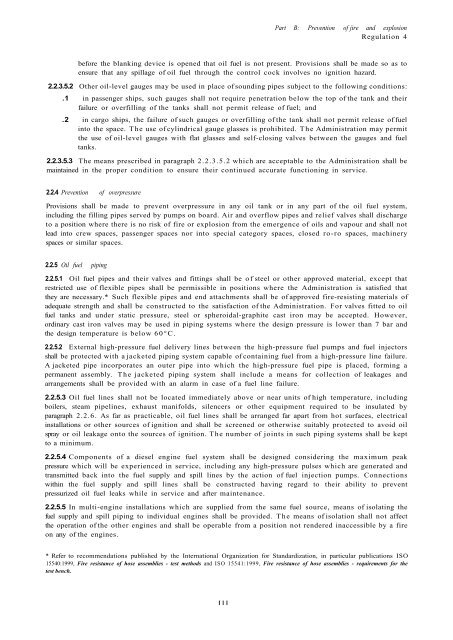Solas Consolidated Edition 2009.pdf
Solas Consolidated Edition 2009 for maritime
Solas Consolidated Edition 2009 for maritime
You also want an ePaper? Increase the reach of your titles
YUMPU automatically turns print PDFs into web optimized ePapers that Google loves.
Part B: Prevention of jire and explosion<br />
Regulation 4<br />
before the blanking device is opened that oil fuel is not present. Provisions shall be made so as to<br />
ensure that any spillage of oil fuel through the control cock involves no ignition hazard.<br />
2.2.3.5.2 Other oil-level gauges may be used in place of sounding pipes subject to the following conditions:<br />
.1 in passenger ships, such gauges shall not require penetration below the top of the tank and their<br />
failure or overfilling of the tanks shall not permit release of fuel; and<br />
.2 in cargo ships, the failure of such gauges or overfilling of the tank shall not permit release of fuel<br />
into the space. The use of cylindrical gauge glasses is prohibited. The Administration may permit<br />
the use of oil-level gauges with flat glasses and self-closing valves between the gauges and fuel<br />
tanks.<br />
2.2.3.5.3 The means prescribed in paragraph 2.2.3.5.2 which are acceptable to the Administration shall be<br />
maintained in the proper condition to ensure their continued accurate functioning in service.<br />
2.2.4 Prevention of overpressure<br />
Provisions shall be made to prevent overpressure in any oil tank or in any part of the oil fuel system,<br />
including the filling pipes served by pumps on board. Air and overflow pipes and relief valves shall discharge<br />
to a position where there is no risk of fire or explosion from the emergence of oils and vapour and shall not<br />
lead into crew spaces, passenger spaces nor into special category spaces, closed ro-ro spaces, machinery<br />
spaces or similar spaces.<br />
2.2.5 Oil fuel piping<br />
2.2.5.1 Oil fuel pipes and their valves and fittings shall be of steel or other approved material, except that<br />
restricted use of flexible pipes shall be permissible in positions where the Administration is satisfied that<br />
they are necessary.* Such flexible pipes and end attachments shall be of approved fire-resisting materials of<br />
adequate strength and shall be constructed to the satisfaction of the Administration. For valves fitted to oil<br />
fuel tanks and under static pressure, steel or spheroidal-graphite cast iron may be accepted. However,<br />
ordinary cast iron valves may be used in piping systems where the design pressure is lower than 7 bar and<br />
the design temperature is below 60°C.<br />
2.2.5.2 External high-pressure fuel delivery lines between the high-pressure fuel pumps and fuel injectors<br />
shall be protected with a jacketed piping system capable of containing fuel from a high-pressure line failure.<br />
A jacketed pipe incorporates an outer pipe into which the high-pressure fuel pipe is placed, forming a<br />
permanent assembly. The jacketed piping system shall include a means for collection of leakages and<br />
arrangements shall be provided with an alarm in case of a fuel line failure.<br />
2.2.5.3 Oil fuel lines shall not be located immediately above or near units of high temperature, including<br />
boilers, steam pipelines, exhaust manifolds, silencers or other equipment required to be insulated by<br />
paragraph 2.2.6. As far as practicable, oil fuel lines shall be arranged far apart from hot surfaces, electrical<br />
installations or other sources of ignition and shall be screened or otherwise suitably protected to avoid oil<br />
spray or oil leakage onto the sources of ignition. The number of joints in such piping systems shall be kept<br />
to a minimum.<br />
2.2.5.4 Components of a diesel engine fuel system shall be designed considering the maximum peak<br />
pressure which will be experienced in service, including any high-pressure pulses which are generated and<br />
transmitted back into the fuel supply and spill lines by the action of fuel injection pumps. Connections<br />
within the fuel supply and spill lines shall be constructed having regard to their ability to prevent<br />
pressurized oil fuel leaks while in service and after maintenance.<br />
2.2.5.5 In multi-engine installations which are supplied from the same fuel source, means of isolating the<br />
fuel supply and spill piping to individual engines shall be provided. The means of isolation shall not affect<br />
the operation of the other engines and shall be operable from a position not rendered inaccessible by a fire<br />
on any of the engines.<br />
* Refer to recommendations published by the International Organization for Standardization, in particular publications ISO<br />
15540:1999, Fire resistance of hose assemblies - test methods and ISO 15541:1999, Fire resistance of hose assemblies - requirements for the<br />
test bench.<br />
Ill


